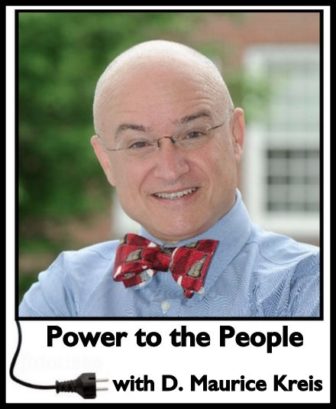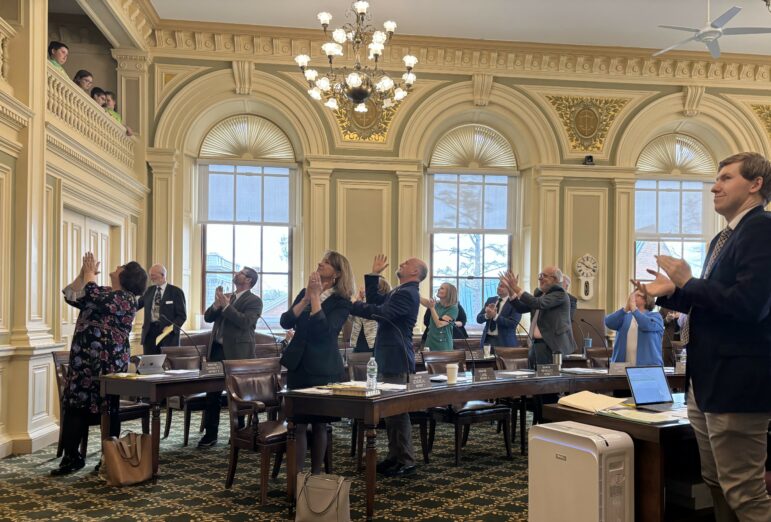Power to the People is a column by D. Maurice Kreis, New Hampshire’s Consumer Advocate. Kreis and his staff of four represent the interests of residential utility customers before the NH Public Utilities Commission and elsewhere. Power to the People is co-published by InDepthNH.org and Manchester Ink Link
By D. Maurice Kreis, Consumer Advocate
Power to the People
There are only two kinds of ratepayer advocates in New Hampshire, at least when it comes to residential utility customers.
One kind is wild about ratepayer-funded energy efficiency. The other isn’t.
Count me among those in the first camp. Electricity is complicated, but a key question is always how much will it cost to serve the next kilowatt-hour (kwh) of demand. Energy efficiency – figuring out a way to eliminate that next kwh of demand without affecting the work we get from the electricity (heating, cooling, lighting, motion, etc.) – is cheaper than every available alternative, be it carbon-belching coal power, groovy solar and wind power, or anything in between.
The other kind of ratepayer advocate, skeptical if not outright opposed to ratepayer-funded energy efficiency, does not claim that energy efficiency is bad. Rather, that kind of advocate thinks we should simply rely on market forces rather than requiring all ratepayers to invest in energy efficiency.
Relying on market forces to drive energy efficiency has a fatal flaw: It doesn’t work because customers do not volunteer to invest in energy efficiency without help. The reason is a complicated mixture of human nature and economics. It is a shame because the benefits of energy efficiency accrue not just to individual customers that invest in it but, really, to all customers because the result is lower fixed costs that would otherwise end up in everyone’s bills.
Correcting that fatal flaw seems like a no-brainer to me as long as we can show that the overall benefits exceed the cost. And, believe me, much ink is spilled and many hours of meetings are consumed in an effort to assure that the benefits of ratepayer-funded energy efficiency exceed the costs.
As Rodgers and Hammerstein famously concluded in their Broadway musical Oklahoma!, “the farmer and the cowman should be friends.” The same is true of the two kinds of ratepayer advocates, since we, just like the farmer and the cowman, all want the same thing – safe and reliable utility service at the lowest possible cost. Truth is, we are friends.
But unlike the farmers and the cowboys of pre-statehood Oklahoma, we two types of ratepayer advocates sometimes confront our differences of opinion via Twitter. For example, a friendly tweet of that sort arrived one Saturday after I proclaimed that “New Hampshire is the Saudi Arabia of nega-barrels because of all our unrealized potential for cost-effective energy efficiency.”
“Sure,” tweeted my friend from the other side of the divide, adding: “Define ‘cost effective’ – does that include avoiding carbon taxes that don’t exist?”
“Avoiding imaginary taxes is not included,” I replied. But it turns out my friend was right, sort of.
New Hampshire does have a carbon tax, in the form of the Regional Greenhouse Gas Initiative (RGGI). But the resulting mandatory purchases of carbon allowances apply only to utility-size generation facilities. Other carbon emissions, such as those produced by cars or oil-burning furnaces, are not taxed.
The avoided cost of RGGI allowances is definitely included in the cost-benefit analysis that determines what energy efficiency measures are funded by ratepayers. And, as of 2019, there’s an additional sum added to the benefit side of the equation – using the value of RGGI allowances as a benchmark – to account for carbon emissions that are avoided by burning less fossil fuels at premises receiving energy efficiency measures.
My signature appears on the November 2018 settlement agreement that recognizes this additional value of avoiding so-called “non-embedded” cost of carbon emissions. For me – and, presumably, for the Public Utilities Commission in approving the settlement – it’s not a matter of using energy efficiency to avoid carbon taxes that don’t exist.
Who’s better off
Instead, it’s a matter of acknowledging that everyone – including, most certainly, residential utility customers – is better off if we reduce carbon emissions by deploying more energy efficiency measures.
Reducing carbon emissions, and pursuing other environmental initiatives, is not an express part of the statutory objectives assigned to the Office of the Consumer Advocate. Generally, therefore, I leave to effective nonprofits like the Conservation Law Foundation, Clean Energy NH, and the Acadia Center the task of explaining to the PUC why climate change is a key imperative in the realm of utility regulation.
But I have no qualms about accounting for the cost of avoided fossil emissions in a manner that places them in closer parity with how we account for electric system emissions, in the name of carbon reduction, when it comes to deciding which energy efficiency programs will receive a boost via ratepayer funds. Especially given that, according to the revised statewide energy efficiency plan filed by the utilities on January 15, all but one of the programs would pass the cost-benefit test without such a boost.
Those who disagree – be they fellow ratepayer advocates, climate change skeptics, or those who think the system benefits charge is really a tax – have a fabulous opportunity ahead of them to make their views felt.
Between now and midsummer, a PUC working group is grappling with what cost-benefit test will apply to our ratepayer-funded energy efficiency programs in the future. To the uninitiated, this looks like an arcane policy conversation. Actually, it is anything but.
One intriguing possibility for all ratepayer advocates to consider: a radical, “back to the future” approach to the way we calculate the costs and benefits of ratepayer-funded energy efficiency.
We could ditch all of the efforts to estimate the costs and benefits to the world at large, or to the individual customers whose premises receive the energy efficiency measures. Instead, we could revert to a so-called “utility cost” test.
Under the utility cost test, we would use ratepayer money to pay for energy efficiency measures only when the resulting cost to the utility (which is borne by ratepayers) is less than the resulting benefit to the utility (which is also borne by customers). Such a rubric would guarantee that ratepayers as a whole pay only for energy efficiency measures that save them money as a whole. This is how they do it in Connecticut (with certain exceptions for public policy reasons, like the desirability of robust energy efficiency programs for low-income households.)
How would that affect our current ratepayer-funded energy efficiency programs? I don’t know, but it’s worth finding out. Because a statewide consensus about how to calculate costs and benefits might get us out of last place when it comes to energy efficiency north of the Mason-Dixon line.





